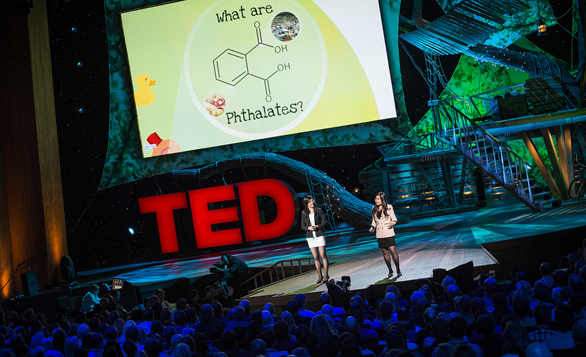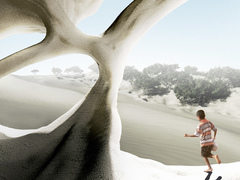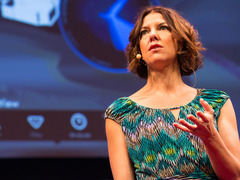
Teen scientists Miranda Wang and Jeanny Yao share an incredible use of bacteria — for breaking down the pthalates in plastic. Photo: James Duncan Davidson
When you think of bacteria, the word ‘heroic’ hardly pops to mind. Bacteria don’t have the best reputation (case in point: the poop problem). But, we are reminded in today’s talk, from teen scientists Miranda Wang and Jeanny Yao, that not all bacteria are our enemies.
Wang and Yao found themselves faced with an immovable problem: an enormous pit of plastic waste at their local Vancouver waste station with nowhere to go except back into the ecosystem, where it would sit for more than 1000 years. They asked: What if you could make a plastic carton disappear as quickly as an apple core, which takes only days to decay.
Bacteria is the invisible solution to this highly visible problem. The duo, with the help of expert mentors, harnessed the degradation potential of the bacteria in the soil of their local Frazer river and cultured it so that it could live off pthalates — a highly pollutant substance in plastic — as its sole source of carbon, and thus break them down.
Wang and Yao aren’t alone in using the incredible powers of these microorganisms to solve everyday problems. Here are six more ways of thinking about helpful bacteria and their uses:
 Magnus Larsson: Turning dunes into architecture
Magnus Larsson: Turning dunes into architecture
Magnus Larsson: Turning dunes into architecture Imagine a 6,000-kilometer-long wall, the size of the Great Wall of China, made from only bacteria and sand. Yes, it can be done, says Magnus Larsson at TEDGlobal 2009. Bacillus pasteurii is a microorganism that takes a pile of sand and transforms it into sandstone. Sand, in this solidified state, would help architects build structures to support human life in the most extreme environments. |
 Jonathan Eisen: Meet your microbes
Jonathan Eisen: Meet your microbes
Jonathan Eisen: Meet your microbes Every person exists in a microbial cloud — we have 10 times as many microbial cells on us as we do human cells. It could be the delicate balance of these microbes — which include bacteria, archaea, eukaryotes and viruses — that keeps us healthy. In this talk from TEDMED 2012, biologist Jonathan Eisen shares some surprising ways that microbes could be used to improve health. |
 Damian Palin: Mining minerals from seawater
Damian Palin: Mining minerals from seawater
Damian Palin: Mining minerals from seawater At TED2012, Damian Palin tackles two pervasive problems at once: inadequate access to clean water and mining for minerals. Filtering seawater is a costly process and leaves behind a salt solution or brine that’s usually tossed back into the ocean, even though it’s toxic. The bacteria Palin is studying can accumulate, precipitate and deposit minerals from the desalination brine. |
 Bonnie Bassler: How bacteria "talk"
Bonnie Bassler: How bacteria "talk"
Bonnie Bassler: How bacteria “talk” We can learn a lot from how bacteria communicate, says Bonnie Bassler in this talk from TED2009. The bacteria covering our body are an “invisible body armor” that protects us from other environmental dangers. Most importantly, they teach the body to keep bad bacteria out. |
 Suzanne Lee: Grow your own clothes
Suzanne Lee: Grow your own clothes
Suzanne Lee: Grow your own clothes Suzanne Lee grows fabric from a kombucha-like cocktail of bacteria, yeasts and other microorganisms. During the fermentation, cellulose threads form and transform into layers. At TED2011, she unveils some of her creations from this material — one is an airy, lightweight, transparent jacket with the feel of vegetable leather. |
 Jessica Green: We're covered in germs. Let's design for that.
Jessica Green: We're covered in germs. Let's design for that.
Jessica Green: We’re covered in germs. Let’s design for that “These creatures define who we are,” says Jessica Green in this talk from TED2013, referring to the trillions of microbes that cover our bodies. What happens when we design the invisible ecosystems and pathways for microbial exchanges? Then, we could have a profound impact on our health and our visible environments. |
 E.O. Wilson: My wish: Build the Encyclopedia of Life
E.O. Wilson: My wish: Build the Encyclopedia of Life
E.O. Wilson calls for an Encyclopedia of Life Bacteria is a crucial part of E.O. Wilson’s proposed Encyclopedia of Life. He emphasizes that bacteria, though not visible, play a significant role in our world and represent an enormous source of biodiversity. Our lives, the lives of other animals, the sea – we all depend on these creatures. Cool fact: There are 500 species of friendly bacteria living in our mouths and throats, keeping the bad ones at bay. |
And as a bonus: imagine what we can learn from the oldest living bacteria. Rachel Sussman shares in the talk, “The oldest living things”…
[ted id=948]
Comments (3)
Pingback: La merveilleuse ingéniosité des bactéries | Tell me your Science